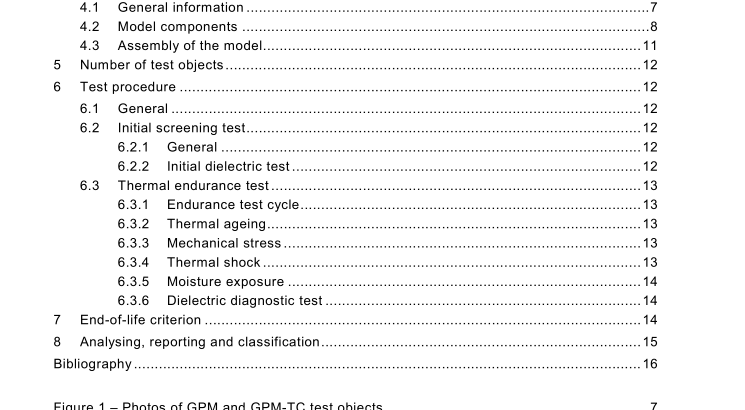IEC 61857-21:2009 pdf download – Electrical insulation systems – Procedures for thermal evaluation – Part 21: Specific requirements for general-purpose models – Wire-wound applications
4 Construction
4.1 General information General-purpose models are useful in evaluating the compatibility of the electrical insulation materials (EIM) being used in a candidate electrical insulation system (EIS). A GPM is not capable of simulating the influence of actual manufacturing processes such as winding techniques. Consequently, the influence of the manufacturing processes will be minimal. A GPM may be assembled by hand, using simple facilities.
The essential components of general-purpose models are either two coils (GPM) or three coils (GPM-TC) mounted in the same pair of channels, thus representing the windings in the window of a transformer, or the windings in the slots of a motor or generator, and EIM placed between the pairing(s) of coils and the coil-to-frame location representing coil-to-coil insulation and earth insulation, respectively (see Figure 1 ).
The channels, representative of the laminations in an electrotechnical product, shall be formed of stainless steel plates in an appropriate manner and fixed to the base. One or more EIM and/or different thicknesses of EIM may be used as earth insulation in the construction. Two insulators for each coil shall be fixed to the base. The coils shall be wound with two winding wires in parallel (bifilar winding). The sets of windings should fill the channels. Each coil may be wound with a different type of winding wire and each type of winding wire shall be in contact with the earth insulation and coil-to-coil insulation. The coils shall be connected to the insulators so as to facilitate the dielectric testing from coil-to-frame, coil-to-coil and conductor-to-conductor. Refer to Figure 2 for the principles of construction of the GPM and to Figure 3 for the principles of construction of the GPM-TC.
4.2 Model components
The components of the model are as follows:
a) Frame:
The frame consists of a rigid supporting metal base with suitable stand-off insulators of porcelain or other appropriate material bolted to one end, and with two channels, formed by an inner and outer sheet, bolted to the other end. See Figure 2 or 3 for specific dimensions. The supporting base has holes for mounting the model during application of mechanical stress (vibration). The assembled channel portion contains two or three coils insulated from the frame by earth insulation, insulated from each other by coil-to-coil insulation and held in place by channel wedges.
b) Coils:
Each coil shall be wound with parallel winding wires for the conductor-to-conductor dielectric test. Coils may be machine-wound, or hand-wound on pins or forms. The ends of the parallel windings shall be isolated to allow conductor-to-conductor testing. When the GPM-TC is being used to evaluate more than one type of winding wire, the EIM being evaluated as coil-to-coil insulation must be placed such that each EIM is in contact with each type of winding wire.
c) Winding wire:
Heavy film-coated. A wire size with a nominal diameter of 1 ,0 mm to 1 ,1 2 mm is preferred.
d) EIM: EIM is used as earth insulation in the channel and as coil-to-coil insulation. EIM qualified as either earth insulation or coil-to-coil insulation in an EIS may be used in either case. EIM shall represent the thickness to be evaluated. EIM placed between the coils shall be of sufficient width to provide a complete insulation barrier between the coils. The EIM in the semicircular section shall be shaped, by cutting or other technique, to follow the curve of the coils and extend wider than the width of the wire wound coils. When the GPM-TC is being used to evaluate the performance of two sets of EIM, it is essential for each type of EIM to be in contact with each type of winding wire. If the EIM placed between the top and middle coils is not the same as that placed between the middle and bottom coils, then the winding wire placed into the top coil shall be the same as is placed into the bottom coil. The middle coil may be wound with an alternate winding wire.
e) Channel wedge:
The wedges shall be of sufficient stiffness to contain the coils in the channel. One end of the wedge shall be rounded to ensure easy passage through the channel.
f) Tie cord and/or electrical grade tape. g) Electrical insulating varnish or resin, if a component of the EIS, shall conform to either IEC 60455 or IEC 60464.
